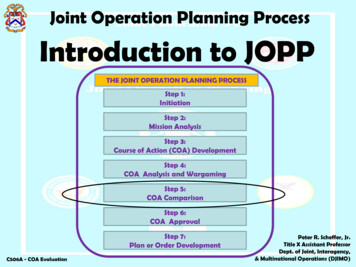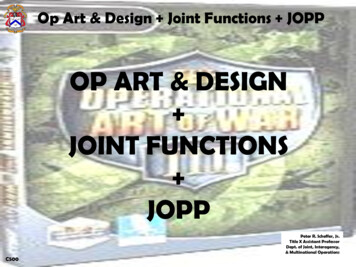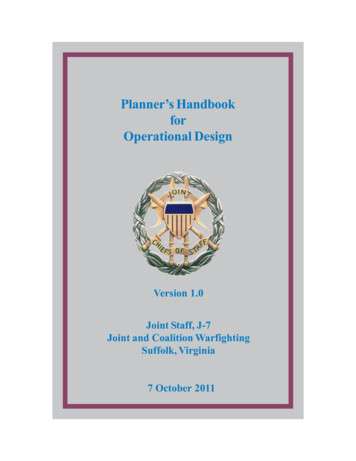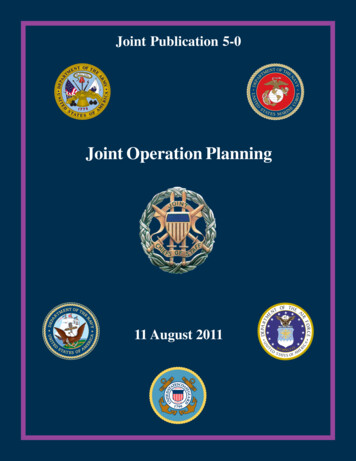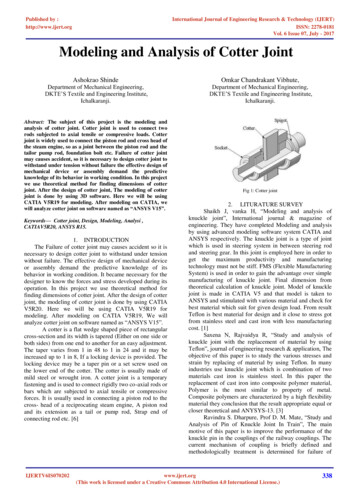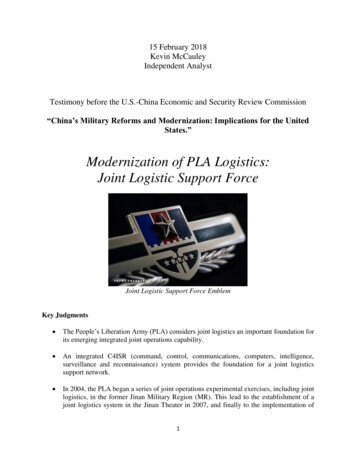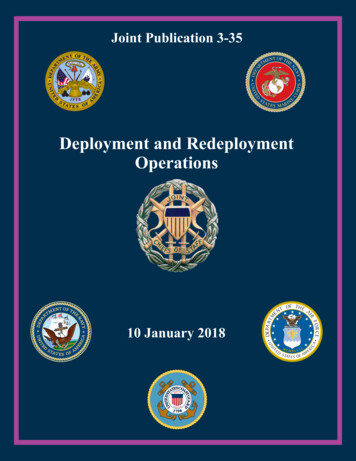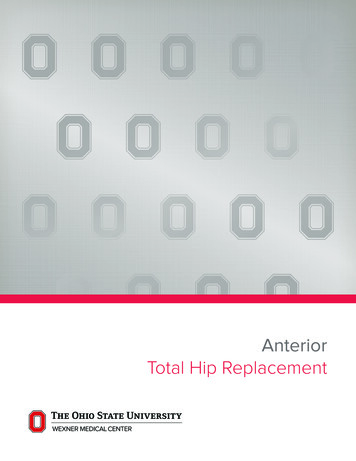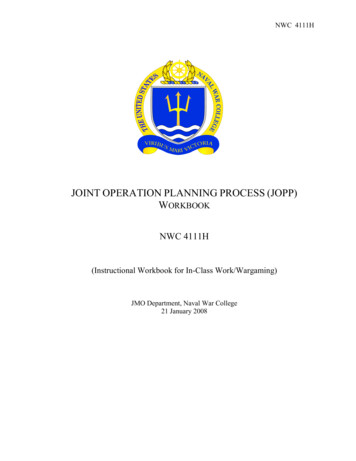
Transcription
NWC 4111HJOINT OPERATION PLANNING PROCESS (JOPP)WORKBOOKNWC 4111H(Instructional Workbook for In-Class Work/Wargaming)JMO Department, Naval War College21 January 2008
NWC 4111HIntentionally Blank
NWC 4111HPREFACEThis document provides a framework to conduct military planning requiring the employment offorces. It is intentionally written for a joint audience, though the concepts and language are alsoapplicable for Navy tactical units. It is based on the Navy's NWP 5-01 Navy Planning, CJCSM3500.5A, Joint Task Force HQ Master Training Guide, U.S. Marine Corps DoctrinalPublications (MCDP) 1 Warfighting and MCDP 6 Command and Control, and MCWP 5-1Marine Corps Planning Process, the U.S. Army Command and General Staff College series ofpublications ST 100-9 The Tactical Decision Making Process, ST 101-5 Command and StaffDecision Processes, Battle Command: Leadership and Decision Making for War and OperationsOther Than War (Draft 2.1), JAWS Campaign Planning Primer, CJCSM 3500.040D UniversalJoint Task List (UJTL), Army War College Campaign Planning Handbook, U.S. Army FM 3.0Operations, U.S. Army FM 5.0 Army Planning and Orders Production, JP 3-0 Joint Operations,JP 5-0 Joint Operation Planning, JP 3-33 Joint Task Force Headquarters, and JP 2-01.3 JointTactics, Techniques, and Procedures for Joint Intelligence Preparation of the OperationalEnvironment, and a variety of products from the U.S. Joint Forces Command Joint WarfightingCenter. We appreciate the language and concepts found in many of these documents and whenappropriate have used their exact wording. The format is designed to accommodate planningrequirements regardless of the size of the force involved, the environment, and the scale of theobjectives to be accomplished. The format is also intended to be applied across the full range ofmilitary operations (ROMO).Summary of Major ChangesThis edition of the NWC 4111 workbook is consistent with the processes and techniques foundin the previous publication NWC 4111G and only serve as an update to those procedures asnecessitated by recent joint doctrinal changes. The most significant adjustments found in thisversion are as follow: The title of the workbook has changed from Commander’s Estimate of the Situation(CES) to Joint Operation Planning Process (JOPP) in order to reflect the broader goal ofthe publication. The steps for the Navy Planning Process (NPP), as reflected in the 2007 version of NWP5-01 Navy Planning, are harmonized with the JOPP, as reflected in the 2006 version ofJP 5-0 Joint Operation Planning. Modifications have been added to reflect the changes induced by JP 5-0 Joint OperationPlanning. These include: Minor changes to course of action (COA) validity criteria; thereplacement of Joint Intelligence Preparation of the Battlespace (JIPB) with the JointIntelligence Preparation of the Operational Environment (JIPOE), the inclusion of effectsconcepts (see Appendix K), and the addition of a new phasing construct for operations. New appendices were added to assist planning activities. These include: enhancedglossary of commonly used terms and acronyms, a detailed description of commandrelationships, and a review of operational art and effects overlaps.Electronic copies of this workbook are available through the Naval War College, Joint MilitaryOperations Department jmo/overview.aspxi
NWC 4111HIntentionally Blankii
NWC 4111HTable of ContentsPagePREFACE. iTHE JOINT OPERATION PLANNING PROCESS (JOPP). 1STEP 1: JOINT INTELLIGENCE PREPARATION OF THE OPERATIONALENVIRONMENT (JIPOE) AND MISSION ANALYSIS (MA) . 1-1PART 1:JOINT INTELLIGENCE PREPARATION OF THE OPERATIONALENVIRONMENT . 1-1PART 2: MISSION ANALYSIS . 1-271. Determine Planning Facts:. 1-282. The Source(s) of the Mission:. 1-283. Identify the “Supported” and “Supporting Commanders” and Agencies:. 1-284. Analyze the Higher Commander's Mission: . 1-285. State the Higher Commander’s Intent: . 1-296. Determine specified, implied, and essential tasks: . 1-317. Identify Externally Imposed Operational Limitations: . 1-338. Analysis of Available Forces and Assets:. 1-349. Identify Higher Command’s Assumptions and Create Your Own Assumptions: . 1-3510. Conduct an Initial Risk Assessment: . 1-3611. Develop Restated Mission Statement: . 1-37Mission Analysis Brief . 1-38Commander’s Guidance and Intent . 1-40Warning Order . 1-44STEP 2: DEVELOPMENT OF FRIENDLY COURSES OF ACTION . 2-11. Generate Options: . 2-12. Test for validity. 2-63. Recommend Command and Control Arrangements:. 2-74. Develop the Course of Action statement and sketch for each COA. 2-7STEP 3: ANALYSIS OF FRIENDLY COURSES OF ACTION (WAR GAME) . 3-11. Organize for the War game:. 3-32. List all Friendly Forces: . 3-43. Review Assumptions. . 3-44. List Known Critical Events:. 3-45. Determine the Governing Factors:. 3-57. Record and Display Results:. 3-68. War game the Operation and Assess the Results:. 3-7iii
NWC 4111HSTEP 4: COURSES OF ACTION COMPARISON AND THE DECISION. 4-11. Governing Factors. 4-12. List Advantages and Disadvantages of Each COA. 4-23. Compare the Merits of COAs. . 4-44. COA Decision. 4-55. Joint Synchronization Matrix. 4-56. Concept of Operations. . 4-6STEP 5: DEVELOPMENT OF PLANS/ORDERS. 5-11. Characteristics. 5-12. Format of Military Plans and Orders. . 5-13. Commander Approval of the Plan/Order. 5-2STEP 6: TRANSITION . 6-11. Transition Brief. 6-12. Confirmation Brief. 6-23. Transition Drills. . 6-2APPENDIX A: JIPOE Products . A-1APPENDIX B: Force Ratio / Force Multiplier Data . B-1APPENDIX C: Center of Gravity Determination. C-1APPENDIX D: Sample Planning Assumptions. D-1APPENDIX E: Risk Assessment .E-1APPENDIX F: Examples of Governing Factors .F-1APPENDIX G: Sample Decision Matrix. G-1APPENDIX H: Joint Synchronization Matrix. H-1APPENDIX I: Plan Rehearsals.I-1APPENDIX J: Command Relationships. J-1APPENDIX K: Integration of Effects into Operational Design . K-1APPENDIX L: Operational Time Definitions.L-1APPENDIX M:Classes of Supply . M-1APPENDIX N: Glossary. N-1APPENDIX O: Abbreviations and Acronyms. O-1iv
NWC 4111HTHE JOINT OPERATION PLANNING PROCESS (JOPP)Military commanders are required to make decisions constantly. Every day, they and theirstaffs resolve simple, routine, and/or complex problems. To help them think through theiroptions when faced with a force employment decision while applying their knowledge,experience and judgment, military staffs use a decision-making tool called the Joint OperationPlanning Process (JOPP).Developing plans is a continuing function of all commanders and staff officers. In reality,all officers involved in military operations are continually revising their original staff estimatesand planning in the light of current developments. The planning process is an ongoing activity,which begins upon receipt of guidance and ends at the conclusion of operations. An entirely newplan and supporting estimates are normally not prepared except when a new operation isundertaken or when a drastic change in the situation renders such action necessary.The process is supported by staff section specific estimates. Most of the staff divisions (e.g.,J-1, J-2, J-3, etc., or Service counterparts) prepare their own estimates of the situation in supportof the JOPP. Pertinent parts of these staff estimates are then inserted, verbatim or in modifiedform, into the final product. See CJCSM 3500.5A, Joint Task Force HQ Master Training Guidefor a good review of each of the staff estimates.JOPP underpins planning at all levels and for missions across the full range of militaryoperations. It applies to both supported and supporting joint force commanders (JFCs) and tojoint force component commands when the components participate in joint planning. Thisprocess is designed to facilitate interaction between and among the commander, staff, andsubordinate headquarters throughout planning. JOPP helps commanders and their staffs organizetheir planning activities, share a common understanding of the mission and commander’s intent,and develop effective plans and orders.This planning process applies to contingency planning and crisis action planning (CAP)within the context of the responsibilities specified by the Chairman of the Joint Chiefs of Staffmanual (CJCSM) 3122 series Joint Operation Planning and Execution System (JOPES). TheJOPP also is also used by joint organizations that have no specific JOPES responsibilities.Furthermore, JOPP supports planning throughout the course of an operation after the Chairmanof the Joint Chiefs of Staff (CJCS), at the direction of the President or Secretary of Defense(SecDef), issues the execute order (EXORD). In common application, JOPP proceeds accordingto planning milestones and other requirements established by commanders at various levels.However, the CJCSM 3122 series specifies joint planning and execution community (JPEC)milestones, deliverables, and interaction points for contingency and crisis action plans developedper the formal JOPES process. Figure 1 shows the primary steps of JOPP.1
NWC 4111HFigure 1. The Joint Operation Planning Process (JOPP) per JP 5-0The JOPP and the NPPPlanning conducted by another Service may differ in format and detail from the JOPP,but all address similar planning issues. The Navy Planning Process (NPP), as detailed in NWP 501 Navy Planning, provides maritime planners with the procedures requisite for high tactical /low operational planning requirements. While the NPP accomplishes the same planning actionsas outlined in the JOPP, it does so in six steps that in some cases combine the processes found inthe Joint Publication 5-0 Joint Operation Planning (such as Mission Analysis and Initiation aswell as COA Comparison and Approval), and in other cases add activities (such as Transition). Itshould also be noted that while the Joint Intelligence Preparation of the Operational Environment(JIPOE) is in fact a product of a staff estimate and not a planning step, its importance to theoverall planning process is so critical that this workbook highlights its presence. This workbookuses the NPP steps (see Figure 2) for explaining the joint planning process; however, unlike thetactically focused NWP 5-01, this workbook retains a focus at the operational level of war. Assuch, for the remainder of this workbook the term JOPP will be used rather than NPP to reflectthe higher order planning requirements demanded by a joint environment and reflected in thisworkbook’s procedures and examples.Note that in practice these steps take place sequentially, but they may be compresseddepending on available planning time, staff experience/capabilities, and the commander'sinvolvement in the process. Additionally, subordinate—or even superior commanders—will beconducting their own parallel planning that require inputs from your command’s process. In2
NWC 4111Hother words, no planning is done in isolation. These steps are described and analyzed heresequentially for instructional purposes only.1.JIPOE andFigure 2. The JOPP using the Navy Planning Process (NPP)JIPOE and Mission Analysis:Step One, Part 1. While not a formal step in the JOPP, though essential to the joint planningstaff’s success, the JIPOE is a product of the Intelligence Staff Estimate. The most importantportions of this estimate are the identification of the enemy’s objectives and respective Center (s)of Gravity (COG) and the enemy’s most likely and dangerous courses of action.Step One, Part 2. Mission analysis drives the JOPP. As the first step of the process its purposeis to review and analyze orders, guidance, intelligence, and other information in order for thecommander, planning team, and staff to gain an understanding of the situation and to produce arestated mission statement for the commander’s approval.Course of Action (COA) Development:Step Two. Planners use the mission statement, commander’s intent, and planning guidance todevelop multiple COAs. Then they examine each prospective COA for validity by ensuringadequacy, feasibility, acceptability, distinguishability, and completeness with respect to thecurrent and anticipated situation, the mission, and the commander’s intent.3
NWC 4111HCourse of Action Analysis (Wargaming):Step Three. Course of action analysis involves a detailed assessment of each COA as it pertainsto the enemy and the operational environment. Each friendly COA is wargamed against selectedECOAs. This step assists planners in identifying strengths, weaknesses, and associated risks, andin assessing shortfalls for each prospective friendly COA. Wargaming also identifies branchesand potential sequels that may require additional planning. Short of execution, COA wargamingprovides the most reliable basis for understanding and improving each COA. This step alsoallows the staff to refine its initial estimates based on additional understanding that is gainedfrom the analysis.Course of Action Comparison and Decision:Step Four. All retained friendly COAs are evaluated against established criteria and against eachother, ultimately leading to a staff recommendation and the commander’s decision.Plans and Orders Development:Step Five. The staff uses the commander’s COA decision, mission statement, commander’sintent, and guidance to develop plans and/or orders that direct subordinate actions. Plans andorders serve as the principal means by which the commander expresses his decision, intent, andguidance.Transition:Step Six. Transition is the orderly handover of a plan or order to those tasked with execution ofthe operation. It provides staffs with the situational awareness and rationale for key decisionsnecessary to ensure that there is a coherent transition from planning to execution. The process,however, does not end here. As depicted in Figure 2, the process is continuous. Staffs maintainrunning estimates that allow for plans and orders refinement. The planning staff continues toexamine branches and sequels to plans and orders.Figure 3 offers a brief summary of the major activities and associated products found in each ofthe JOPP steps.4
NWC 4111H 1-5Figure 3. JOPP Major Activities and ProductsSTEP 1Joint IntelligencePreparation of theOperationalEnvironmentMISSIONANALYSISPRODUCTS Operational environment Effects Enemy Critical Factors ECOAs Initial Collection RequirementsSTEP 2STEP 3 Mission Analysis Briefo Restated Mission Commander'so Planning Guidanceo Intent Warning OrderCOADEVELOPMENT COA BriefCOA ANALYSIS( WARGAMING)STEP 4COA COMPARISONAND DECISIONSTEP 5STEP 6PLANS AND ORDERSDEVELOPMENTTRANSITION War Game Refined CollectionPlan Adv/Disadv each COA Approved COA 2d Warning Order Plan/Order Handover of 5DevelopmentJoint SynchMatrixPlan/OrderRehearsals
Intentionally Blank6
NWC 4111HSTEP 1: JOINT INTELLIGENCE PREPARATION OF THE OPERATIONALENVIRONMENT (JIPOE) AND MISSION ANALYSIS (MA)PART 1: JOINT INTELLIGENCE PREPARATIONOF THE OPERATIONAL ENVIRONMENTTHE PURPOSE OF THE JIPOE PORTION OF THIS PLANNER’S WORKBOOK IS NOT TOMAKE THE USER A JIPOE EXPERT. THE INTENT IS TO EXPOSE THE NONINTELLIGENCE STAFF OFFICER/PLANNER TO A CRITICAL ASPECT OF THEPLANNING PROCESS, WHICH IS ON-GOING THROUGHOUT THE PLANNING ANDEXECUTION OF AN OPERATION. ALL PLANNERS NEED A BASIC FAMILIARITY OFTHE JIPOE PROCESS IN ORDER TO BECOME CRITICAL CONSUMERS OF THEPRODUCTS PRODUCED BY THE J2/G2/N2/A2. THE JIPOE SERVES AN INTEGRALSUPPORTING ROLE TO THE OVERALL PLANNING PROCESS. SOME OF THE STEPSIN THE JIPOE ARE CONDUCTED IN PARALLEL WITH THE MISSION ANALYSIS ANDWILL REQUIRE INPUT FROM OTHER MEMBERS OF THE JOINT PLANNING TEAM.SEE APPENDIX A FOR GREATER JIPOE DETAILS AND JOINT PRODUCTEXAMPLES.Joint Intelligence Preparation of the Operational Environment (JIPOE) is the analyticalprocess to produce intelligence assessments, estimates, and other intelligence products. Theprimary purpose of JIPOE is to support the joint force commander’s (JFC’s) decision-makingand planning by identifying, assessing, and estimating the enemy’s center(s) of gravity(COG)(s), critical factors, capabilities, limitations, intentions, and courses of action (COAs) thatare most likely to be encountered based on the situation. Using the JIPOE process, the joint forceintelligence directorate (J-2) manages the analysis and development of products that provide asystems understanding of the increasingly complex and interconnected operationalenvironment—the composite of the conditions, circumstances, and influences that affect theemployment of capabilities and bear on the decisions of the commander.Although JIPOE support to decision-making is both dynamic and continuous, it must also be“front loaded” in the sense that the majority of analysis must be completed early enough to befactored into the commander’s decision-making effort. JIPOE generally occurs in parallel tomission analysis, and supports mission analysis by enabling the commander and staff to visualizethe full extent of the operational environment, to distinguish the known from the unknown, andto establish working assumptions regarding how adversary and friendly forces will interactwithin the operational environment. JIPOE also assists commanders in formulating theirplanning guidance by identifying significant adversary capabilities and by pointing out criticaloperational environment factors, such as weather and terrain; the locations of key geography;environmental and health hazards; attitudes of indigenous populations; and potential land, air,and sea avenues of approach. Of growing significance in JIPOE are considerations in theinformation environment, which are not limited to an adversary and will have ramificationsacross all phases of a planned military operation. As planning continues, analysts refine theirassessment of the adversary’s centers of gravity (COGs), potential enemy courses of action(ECOAs), and other factors.1-1
NWC 4111HThe operational environment encompasses the air, land, sea, space, the informationenvironment, and associated adversary, friendly, and neutral systems (political, military,economic, social, informational, infrastructure, legal, and others), which are relevant to a specificjoint operation. Understanding this environment has always included a perspective broader thanjust the adversary's military forces and other combat capabilities within the traditionaloperational environment. However, current and future strategic and operational requirements andtypes of operations can benefit by a more comprehensive view of all systems in this environmentrelevant to the mission and operation at hand.In order for the joint force staff to identify potential COAs, the Joint Force Commander(JFC) must formulate planning guidance based on an analysis of the friendly mission. Thisanalysis helps to identify specified, implied, and essential tasks; possible branches and sequels;and any limitations on the application of military force. JIPOE supports Mission Analysis byenabling the commander and staff to visualize the full extent of the operational environment, todistinguish the known from the unknown, and to establish working assumptions regarding howadversary and friendly forces will interact within the limitations of the operational environment.JIPOE also assists commanders in formulating their planning guidance by identifying significantadversary capabilities and by pointing out critical operational environment factors, such as thelocations of key geography, attitudes of indigenous populations, and potential land, air, sea, andinformational avenues of approach. MA and the commander’s planning guidance form the basisfor the subsequent development of friendly COAs by the staff.JIPOE is a continuous process, which enables JFCs and their staffs to visualize the fullspectrum of adversary capabilities and limitations as well as potential Enemy Courses of Action(ECOAs) across all dimensions of the operational environment. While JIPOE is most often seenas part of the joint planning process, it is actually conducted both prior to and during operations.Just as the commander must continually make decisions about the course of a campaign oroperation, the intelligence staff must constantly work to seek out, analyze, and disseminate newinformation to support those decisions. Although the specifics of the process vary depending onthe situation and force involved, there is general agreement on the four major steps of JIPOE.I. DEFINE THE OPERATIONAL ENVIRONMENT.This first step is an initial survey of the geographic and non-geographic dimensions of theoperational environment. It is used to bound the problem and to identify areas for furtheranalysis. There are generally three tasks that must be accomplished.1. Identify the Area of Operations and the Area of Interest. Much of the informationmay be provided in the superior’s order or OPLAN, but usually this step requires coordinationwith the J-5, J-3, or other elements of the staff. If a Joint Operations Area (JOA) or otheroperational areas have been identified, they will help guide the intelligence requirements andcollection plan. The operations area, or Area of Operations (AO), is generally the area of directconcern to the commander and intelligence will be focused on this area. The Area of Interest(AOI) is usually a larger area, including areas that may influence the operation, but might not beunder direct operational control of the commander. Intelligence activities will also be focused onthis area, but not necessarily to the same degree as on the AO. The AO and AOI may differ foreach dimension of warfare—land, maritime, air, space, and cyberspace – and may need to be1-2
NWC 4111Hadjusted later in the planning process (e.g., if additional threats are identified outside the definedareas which may impact upon the commander’s AO).(Joint) Area of Operations:(Recommend this be displayed on a map/chart for clarity and reference)Area of Interest:2. Determine the Significant Characteristics of the Operational Environment. This substep is an initial review of the factors of space, time, and forces and their interaction with oneanother. Examining these factors in general terms early in the process will help initiateintelligence collection and other activities that will support the later steps of the planningprocess. This review will require information on friendly forces and how the factors of space andtime affect them. For this reason, the J2 staff must work closely with the J5, J3, and other staffmembers throughout the process.3. Evaluate Existing Data Bases and Identify Intelligence Gaps and Priorities. In thissub-step, intelligence personnel review the information found in various automated databases,Intelink sites (the classified version of the internet), and other intelligence sources, bothclassified and unclassified. The staff begins to coordinate with local, theater, and nationalintelligence organizations that may provide support to the operation, and initiates newintelligence collection and production requests as necessary. Intelligence requests andrequirements may take the form of: Priority Intelligence Requirements (PIRs). These are the commander’s intelligencepriorities for the operation that will drive all intelligence activities used in support ofCommander’s Critical Information Requirements (CCIRs) to be discussed later. The J2staff will normally develop and propose PIRs for the commander’s approval.1-3
NWC 4111H Requests for Information (RFIs). This is a general term that may be used by operationsor other personnel who need timely information from the intelligence staff or anintelligence organization concerning an aspect of the operation. If the information isreadily available, such as through the Joint Intelligence Center (JIC), the RFI will beanswered directly. If the answer will require additional analytical work, a productionrequest may be necessary. Production Requests (PRs). These are used to request the development of new studies,reports, and other intelligence products. For example, if the initial review of availableintelligence revealed that little information existed on the enemy’s information operationscapability, a PR might be sent by the J2 staff to the theater JIC, requesting that thisinformation be provided by a certain date. If the information to answer such a requestdoes not currently exist in the intelligence community, a collection requirement may beplaced. Collection Requirements (CRs). These may take many forms, depending on theinformation needed and the collection assets available to get it. For example, someinformation may be available through the tasking of a theater intelligence collector suchas U-2 aircraft. The J2 staff collection managers process these requirements and it is theirjob to determine where and how to best get the necessary intelligence.This step is only a preliminary review of the intelligence available; the J2 staff will continueto levy intelligen
The steps for the Navy Planning Process (NPP), as reflected in the 2007 version of NWP 5-01 Navy Planning, are harmonized with the JOPP, as reflected in the 2006 version of JP 5-0 Joint Operation Planning. Modifications have been added to reflect the changes induced by JP 5-0 Joint Operation Planning. These include: Minor changes to .
